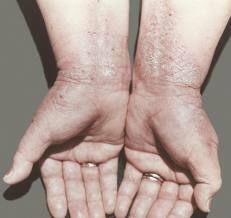Types of allergies
 According to statistics, today about half of the world's population suffers from any kind of allergy. To be able to protect yourself from quite unpleasant manifestations of allergic reactions, it is very important to find out in time what kind of allergy is causing anxiety, exclude repeated contact with provoking allergens and observe certain mandatory rules, the performance of which will help to increase the immune resistance of the organism.
According to statistics, today about half of the world's population suffers from any kind of allergy. To be able to protect yourself from quite unpleasant manifestations of allergic reactions, it is very important to find out in time what kind of allergy is causing anxiety, exclude repeated contact with provoking allergens and observe certain mandatory rules, the performance of which will help to increase the immune resistance of the organism.
Due to their individual genetic characteristics, all people have an absolutely different degree of reactivity to different allergens. Sometimes the symptoms of allergy are so weak that a person does not even suspect that they are predisposed to the disease. Conversely, an allergy is able to be extremely dangerous, causing the development of life-threatening pathological conditions such as anaphylactic shock and Quincke's edema. These conditions represent a real danger to life and often lead to fatal consequences.
Allergy types of allergic reactions :
• Atopy. At the heart of the development of this allergic reaction are hereditary factors. Atopy is manifested by a predisposition to the development of immunoglobulins E( home dust, pollen, etc.) that react to allergens. E. Atopy has three main forms: atopic asthma with sensitization to domestic and domestic dust, mites and other household allergens;Hay fever( pollen bronchial asthma, rhinitis, conjunctivitis) and atopic dermatitis
• Pseudoallergia. This condition has similar symptoms( edema, hives, rhinitis, asthma), but genetic predisposition to the production of immunoglobulin E in such people is not observed, and their body is sensitized particularly difficult. Immune character psevdoallergic reactions do not carry
• Skin allergy. Food, cosmetic and medicinal products, latex, various metals, household chemicals and other similar allergens directly affect the skin or enter the body through the digestive system. It is these above allergens that usually cause the development of skin allergic reactions such as allergic dermatoses, which include contact dermatitis, exudative diathesis( atopic dermatitis), urticaria and eczema. Allergies to the skin are manifested by severe itching, rashes( burning, blisters, swelling) or eczema( change in skin pattern, peeling and dry skin)
• Allergy of the respiratory tract( respiratory allergy).This type of allergy provokes the airborne small allergens, which include particles of wool and animal dander, fragments of cockroaches and house dust mites, plant pollen, spores of mold fungi and many other allergens. Being in the ambient air, these particles in people prone to developing an allergic reaction provoke a regular runny nose, sneezing, bronchitis and possible suffocation. In addition, allergic conjunctivitis( severe eyelid edema, watery eyes), bronchial asthma, allergic rhinitis( year-round) and pollinosis( manifests regularly but is seasonal in nature) belong to the manifestations of this type of allergy.
• Food allergy. In the beginning I want to emphasize that in addition to true food allergy there is a pseudo-food allergy, based not on the immune reaction of the body. Pseudo-allergic condition usually arises against the background of the presence in the consumed food of histamine, or its release in the digestive tract in the process of biochemical transformations. Pseudo-allergy is often observed in children up to two years due to excessive introduction of various lures, or non-compliance with the order and timing of the introduction of new foods. Often this condition is accompanied by dysbacteriosis.
A true food allergy develops as a result of the reaction of the immune defense and is characterized by a certain symptomatology. Symptoms of this kind of allergies are quite diverse( itching, hives, eczema, Quincke's edema, rhinitis, diarrhea, vomiting, abdominal pain, anaphylactic shock, etc.) and can occur with delay or instantly after exposure to an allergen. The most common types of food allergies: allergies to seafood, fish, chicken, nuts, egg white and cow's milk
• Drug allergy. Allergy to medicines is expressed by the immune reaction of the body to certain medications, or to products that are formed in the body during the conversion of drugs( metabolites).Drug allergy should be distinguished from other reactions, which include side effects, intolerance and overdose. For example, the side effect of antihistamines is drowsiness, antibiotics of a wide spectrum of action cause dysbacteriosis, etc. The drug allergy manifests itself in different ways, ranging from almost imperceptible itching and ending with severe damage to the internal organs and skin, as well as asthma
• Allergy to insect bites. Allergies to bites of hornets, bees and wasps are usually manifested by common symptoms, which include dizziness, suffocation, hives, decreased pressure and weakness, and also characteristic swelling in the form of an enlarged red painful blister. Quite often this type of allergy is accompanied by anaphylactic shock, in which there is weakness, the general condition deteriorates sharply, spasms and pains in the abdomen, vomiting and swelling of the larynx are observed. In case of untimely rendering of medical care, anaphylactic shock usually leads to a lethal outcome. In case of ingestion of respiratory products and particles of insect bodies, the symptoms of bronchial asthma
may be present. • Infectious allergy. At the heart of this allergic reaction is an increased response of the body to opportunistic and non-pathogenic microbes. For example, a fairly large number of people in the bronchi are constantly "living" such microorganisms as subflava, flav, Neiseria Perflav. Such microbes are not dangerous for a healthy person, however, if there is an allergy to any of these microorganisms, the development of infectious-allergic bronchial asthma
is possible. • Allergy to the sun. This allergic reaction can be both congenital and acquired. Photodermatosis( acquired solar allergy) begins to appear after prolonged exposure to the skin of the sun's rays, and often in combination with other side irritant factors like chlorine in the pool, plant pollen, cream, deodorant
• Animal allergy. Animal allergens are perhaps one of the most common allergens, with both animal farm animals and domestic animals serving as sources. The most allergenic activity is possessed by feathers, dandruff, wool, saliva, excrement and urine of animals. The cause of the development of an allergic disease can be absolutely all animals, both contained houses, and those with which, for certain reasons, long-term contact is possible. Animal allergens have very high volatility. Most often they are attached to the smallest particles of dust, which for a very long time soar in the ambient air. After a certain period of time, allergens fall on the floor, furniture, walls, mixing with the dust already present there. This type of allergy is usually manifested in the form of conjunctivitis and allergic rhinitis, sometimes bronchial asthma may develop
• Allergy to latex. Latex is a whitish liquid extracted from the juice of rubber trees, which is used as a macromolecular substance, together with some other chemical substances, to produce balloons, condoms, gloves, etc. This allergic reaction is developed due to the fact that in latex there are about two hundred allergenicFractions of proteins. Allergy to latex is usually manifested by skin symptoms, which develops after contact with latex containing products. Also, the smallest particles of latex can be transmitted through the air, which seriously hinders attempts to avoid contact with it. The prevalence of this type of allergy among honey. Workers from 10 to 25%.



